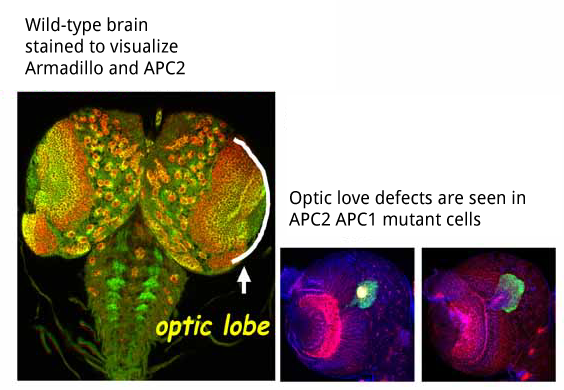Melissa Hayden | 2001-2007
 Ph. D. student in the IBMS Program and the Curriculum in Genetics and Molecular Biology
Ph. D. student in the IBMS Program and the Curriculum in Genetics and Molecular Biology
Currently, Clinical Cytogenetics Fellow, UNC-CH School of Medicine
Functions of the APC tumor suppressor homologs in Wnt signaling and cytoskeletal regulation
The APC gene encodes a multi-domain protein that was first characterized as a tumor suppressor. It acts as a negative regulator of the Wnt/Wingless (Wg) signaling pathway. Mutations in human APC are the first step in the development of colon carcinoma. APC acts in a complex with several other proteins to negatively regulate the levels of free Armadillo, helping to facilitate its phosphorylation and thus directing it for subsequent ubiquitin-mediated destruction. In addition, APC has been shown to have Wg-independent roles in the regulation of the cytoskeleton during normal development. Two APC genes have been identified in both mammals and in Drosophila (APC1 and APC2). We have found that APC1 and APC2 play redundant roles in larval brain development. Using the MARCM strategy, we have generated GFP positively marked APC1 APC2 double mutant clones in the larval brain to examine what role APCs play there. APC2 has a striking asymmetric localization in larval central brain neuroblasts which overlaps that of the cadherin-catenin complex. We are investigating whether this reflects a role for APCs in asymmetric neuroblast division.

We have already found striking defects in optic lobe development in double mutant clones. These defects arise in both epithelial tissues and neuronal projections, giving rise to the segregation of mutant epithelial neuroblasts from their wild type neighbors and to tangled axonal “knots” in neurons. Further studies are underway to identify how the defects seen relate to changes in cell adhesion and/or altered regulation of the cytoskeleton.
Publications
- Hayden, M.A., Akong, K., and Peifer, M. (2007). Novel roles for APC family members and Wingless/Wnt signaling during Drosophila brain development. Developmental Biology 305:358-76.
- McCartney BM, Price MH, Webb RL, Hayden MA, Holot LM, Zhou M, Bejsovec A, Peifer M. (2006). Testing hypotheses for the functions of APC family proteins using null and truncation alleles in Drosophila. Development 133:2407-18
- Akong, K., Grevengoed, E.E., Price, M.H., McCartney, B.M., Hayden, M.A., DeNofrio, J.C., and Peifer, M. (2002). Drosophila APC2 and APC1 play overlapping roles in Wingless signaling in the embryo and imaginal discs. Developmental Biology 250, 91-100.
- Hayden MA, Lange PA, Nakayama DK. (2001) Nitric oxide and cyclic guanosine monophosphate stimulate apoptosis via activation of the Fas-FasL pathway. J Surg Res.101:183-9.
- Hayden MA, Nakayama DK. (1999) Cyclic nucleotides and inducible nitric oxide synthesis in pulmonary artery smooth muscle. J Surg Res. 82:222-7.
- Henrich VC, Szekely AA, Kim SJ, Brown NE, Antoniewski C, Hayden MA, Lepesant JA, Gilbert LI. (1994) Expression and function of the ultraspiracle (usp) gene during development of Drosophila melanogaster. Dev Biol. 165:38-52.


